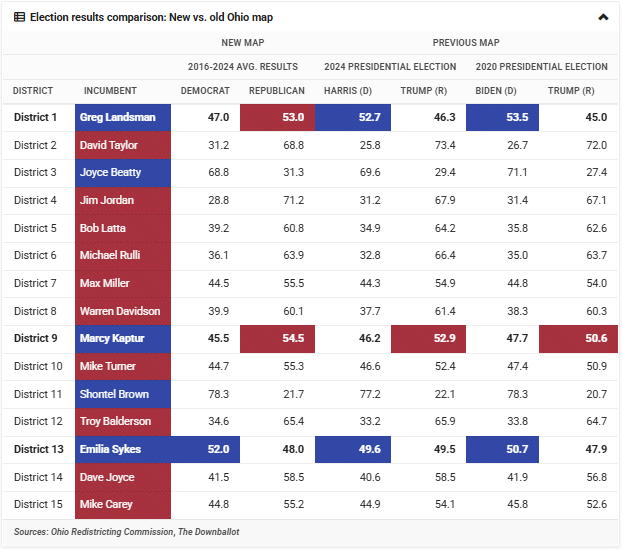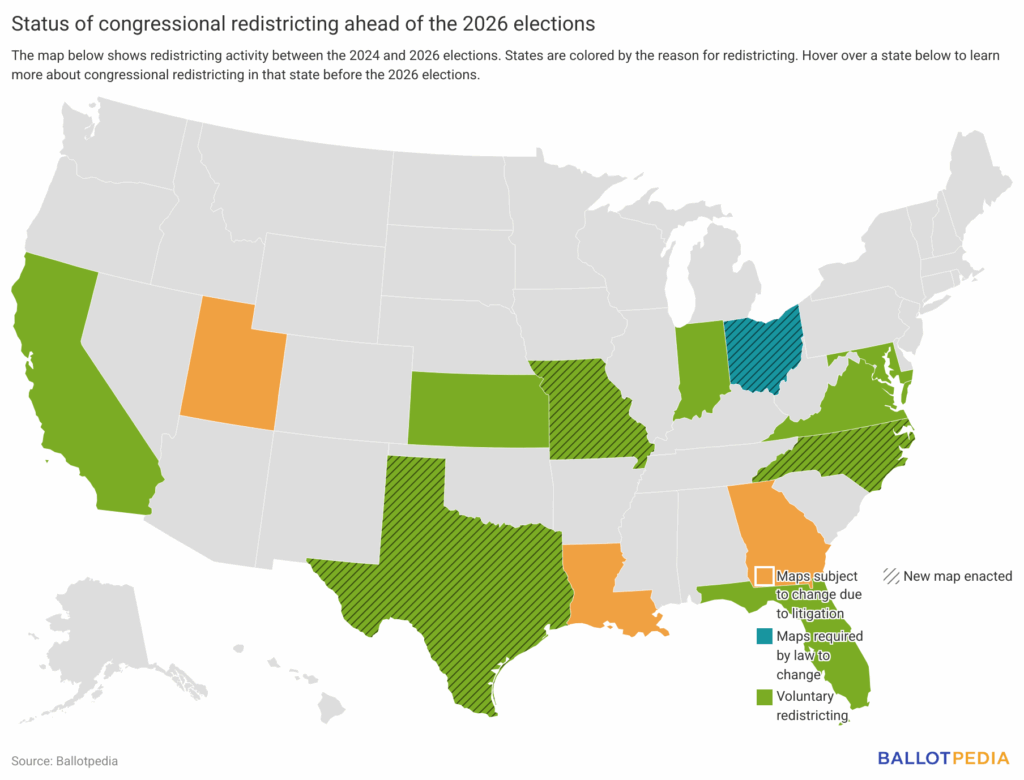Ohio became the fourth state to redraw its congressional district boundaries ahead of the 2026 elections. On Oct. 31, 2025, the Ohio Redistricting Commission voted unanimously to approve a compromise map that, according to data from the commission based on recent statewide election results, could make two districts more competitive for Republicans.
Ohio was the only state required by law to redistrict, and the reason was that the commission’s 2022 map did not have bipartisan support. It follows Missouri (+1 Republican district), North Carolina (+1 Republican district), and Texas (+5 Republican districts), which each redistricted voluntarily.
Under the terms of a 2018 constitutional amendment favoring maps passed with bipartisan approval, the Legislature had the first opportunity to adopt a bipartisan map by the end of September this year. Because it did not pass a bipartisan map, the redistricting commission had the opportunity to adopt a bipartisan map by the end of October. Had it not adopted one, the Legislature could have passed a map in November by a simple majority vote.
Politico’s Jacob Wendler wrote, “Republicans in Ohio opted to reach the agreement with commission Democrats instead of going through the GOP-controlled Legislature. Should a map have been passed by lawmakers, which likely would have resulted in a 13-2 map, a potential ballot referendum could have blocked it for 2026.”
The table below shows how the new districts voted on average in statewide elections between 2016 and 2024—data shared by the commission—compared to the previous map’s results in the 2020 and 2024 presidential elections.
Bolded in the table are the three districts that, earlier in October, Commission Chair Rep. Brian Stewart (R) called “the most hotly contested races generally” and “probably the seats that are most discussed when we're talking about whether there's going to be a deal."

Counting Ohio Districts 1 and 9, redrawn maps nationwide could create nine new Republican-leaning districts. Voters in California will vote on Nov. 4, 2025, on whether to approve a constitutional amendment that would allow the adoption of a map designed to net four Democratic districts.
The Virginia General Assembly also completed its first of what would be two required rounds of approval for a constitutional amendment to allow mid-decade redistricting to proceed in the state. Constitutional amendments in Virginia must be approved in two consecutive sessions with an election in between before appearing before voters on the ballot.
On Oct. 27, 2025, the Virginia General Assembly adopted a resolution that allowed the legislature to consider a constitutional amendment for mid-decade redistricting during its special session. On Oct. 29, 2025, the Virginia House of Delegates voted 51-42 along party lines to approve a constitutional amendment that would allow the state to redraw its congressional lines. The Virginia Senate followed with a 21-16 party-line vote on Oct. 31, 2025.

Other states could still redraw
Kansas Senate President Ty Masterson (R) announced the upper chamber had achieved the required two-thirds threshold of signatures for a petition to call a special session. If the House reaches the same threshold, the legislature could call a special session to consider a new map.
Indiana House Speaker Todd Huston (R) said the legislature would not be ready to meet on Nov. 3, 2025, the first day of the special session Gov. Mike Braun (R) called on Oct. 27. The session will last the shorter of 30 session days or 40 calendar days.
Others include:
- Florida, where the House’s Select Committee on Congressional Redistricting has reportedly not yet met.
- Maryland, where Gov. Wes Moore (D) could call a special session for redistricting, though Senate President Bill Ferguson (D) said redistricting was “too risky and jeopardizes Maryland’s ability to fight against the radical Trump Administration.”
- Utah, where a district judge has until Nov. 10 to consider the map proposals submitted in response to a court-ordered redraw.


